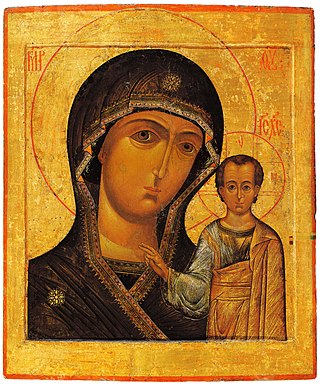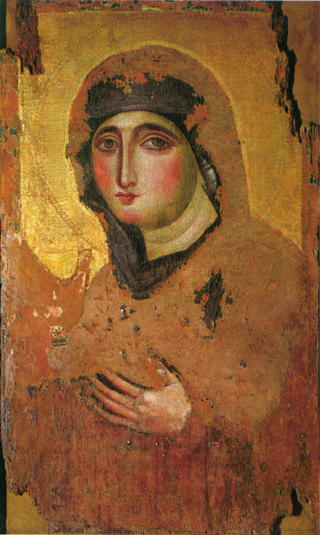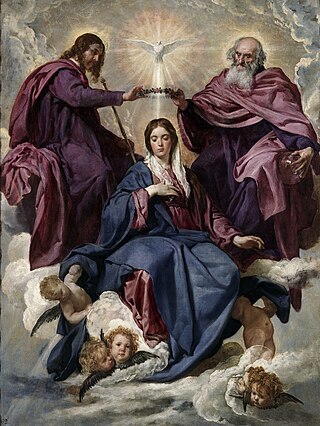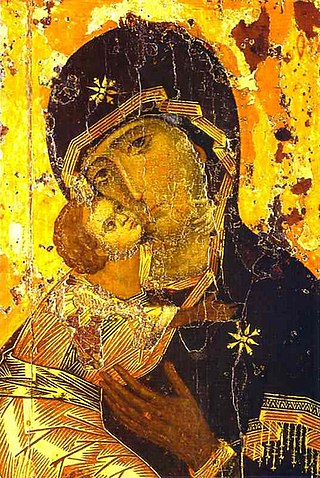
The Gospel of James is a second-century infancy gospel telling of the miraculous conception of the Virgin Mary, her upbringing and marriage to Joseph, the journey of the couple to Bethlehem, the birth of Jesus, and events immediately following. It is the earliest surviving assertion of the perpetual virginity of Mary, meaning her virginity not just prior to the birth of Jesus, but during and afterwards, and despite being condemned by Pope Innocent I in 405 and rejected by the Gelasian Decree around 500, became a widely influential source for Mariology.

Pseudo-Dionysius the Areopagite was a Greek author, Christian theologian and Neoplatonic philosopher of the late 5th to early 6th century, who wrote a set of works known as the Corpus Areopagiticum or Corpus Dionysiacum.

Theotokos is a title of Mary, Mother of God, used especially in Eastern Christianity. The usual Latin translations are Dei Genitrix or Deipara. Familiar English translations are "Mother of God" or "God-bearer" – but these both have different literal equivalents in Greek, Μήτηρ Θεοῦ and Θεοφόρος.

Mary was a first-century Jewish woman of Nazareth, the wife of Joseph and the mother of Jesus. She is a central figure of Christianity, venerated under various titles such as virgin or queen, many of them mentioned in the Litany of Loreto. The Eastern and Oriental Orthodox, Church of the East, Catholic, Anglican, and Lutheran churches believe that Mary, as mother of Jesus, is the Mother of God. Other Protestant views on Mary vary, with some holding her to have lesser status.

Maximus the Confessor, also spelled Maximos, otherwise known as Maximus the Theologian and Maximus of Constantinople, was a Christian monk, theologian, and scholar.

The Assumption of Mary is one of the four Marian dogmas of the Catholic Church. Pope Pius XII defined it on 1 November 1950 in his apostolic constitution Munificentissimus Deus as follows:
We pronounce, declare, and define it to be a divinely revealed dogma: that the Immaculate Mother of God, the ever-Virgin Mary, having completed the course of her earthly life, was assumed body and soul into heavenly glory.

Queen of Heaven is a title given to the Virgin Mary, by Christians mainly of the Catholic Church and, to a lesser extent, in Anglicanism, Lutheranism, and Eastern Orthodoxy. The title has long been a tradition, included in prayers and devotional literature and seen in Western art in the subject of the Coronation of the Virgin from the High Middle Ages, long before it was given a formal definition status by the Church.

The Dormition of the Mother of God is a Great Feast of the Eastern Orthodox, Oriental Orthodox, and Eastern Catholic Churches. It celebrates the "falling asleep" (death) of Mary the Theotokos, and her being taken up into heaven. The Feast of the Dormition is observed on August 15, which for the churches using the Julian calendar corresponds to August 28 on the Gregorian calendar. The Armenian Apostolic Church celebrates the Dormition not on a fixed date, but on the Sunday nearest 15 August. In Western Churches the corresponding feast is known as the Assumption of Mary, with the exception of the Scottish Episcopal Church, which has traditionally celebrated the Falling Asleep of the Blessed Virgin Mary on August 15.
The Clementine literature is a late antique third-century Christian romance or "novel" containing a fictitious account of the conversion of Clement of Rome to Christianity, his subsequent life and travels with the apostle Peter and an account of how they became traveling companions, Peter's discourses, and finally Clement's family history and eventual reunion with his family. To reflect the pseudonymous nature of the authorship, the author is sometimes referred to as Pseudo-Clement. In all likelihood, the original text went by the name of Periodoi Petrou or Circuits of Peter; sometimes historians refer to it as the "Basic Writing" or "Grundschrift".

The perpetual virginity of Mary is a Christian doctrine that Mary, the mother of Jesus, was a virgin "before, during and after" the birth of Christ. In Western Christianity, the Catholic Church adheres to the doctrine, as do some Lutherans, Anglicans, Reformed, and other Protestants. The Oriental Orthodox Churches also adhere to this doctrine as part of their ongoing tradition, and Eastern Orthodox churches recognize Mary as Aeiparthenos, meaning "ever-virgin". It is one of the four Marian dogmas of the Catholic Church. Most modern nonconformist Protestants reject the doctrine.

The New Testament apocrypha are a number of writings by early Christians that give accounts of Jesus and his teachings, the nature of God, or the teachings of his apostles and of their lives. Some of these writings were cited as scripture by early Christians, but since the fifth century a widespread consensus has emerged limiting the New Testament to the 27 books of the modern canon. Roman Catholic, Eastern Orthodox, and Protestant churches generally do not view the New Testament apocrypha as part of the Bible.

The Gospel of Mary is an early Christian text discovered in 1896 in a fifth-century papyrus codex written in Sahidic Coptic. This Berlin Codex was purchased in Cairo by German diplomat Carl Reinhardt.

The Latin Gospel of Pseudo-Matthew is a part of the New Testament apocrypha. In antiquity, the text was called The Book About the Origin of the Blessed Mary and the Childhood of the Savior. Pseudo-Matthew is one of a genre of "Infancy gospels" that seek to fill out the details of the life of Jesus of Nazareth up to the age of 12, which are briefly given in the Gospels of Matthew and Luke. In the West, it was the dominant source for pictorial cycles of the Life of Mary, especially before the Late Middle Ages.

Mariology is the theological study of Mary, the mother of Jesus. Mariology seeks to relate doctrine or dogma about Mary to other doctrines of the faith, such as those concerning Jesus and notions about redemption, intercession and grace. Christian Mariology aims to place the role of the historic Mary in the context of scripture, tradition and the teachings of the Church on Mary. In terms of social history, Mariology may be broadly defined as the study of devotion to and thinking about Mary throughout the history of Christianity.

David Friedrich Strauss was a German liberal Protestant theologian and writer, who influenced Christian Europe with his portrayal of the "historical Jesus", whose divine nature he explored via myth. His work was connected to the Tübingen School, which revolutionized study of the New Testament, early Christianity, and ancient religions. Strauss was a pioneer in the historical investigation of Jesus.

The Church Fathers, Early Church Fathers, Christian Fathers, or Fathers of the Church were ancient and influential Christian theologians and writers who established the intellectual and doctrinal foundations of Christianity. The historical period in which they worked became known as the Patristic Era and spans approximately from the late 1st to mid-8th centuries, flourishing in particular during the 4th and 5th centuries, when Christianity was in the process of establishing itself as the state church of the Roman Empire.
The Dialogue of Jason and Papiscus is a lost early Christian text in Greek describing the dialogue of a converted Jew, Jason, and an Alexandrian Jew, Papiscus. The text is first mentioned, critically, in the True Account of the anti-Christian writer Celsus, and therefore would have been contemporary with the surviving, and much more famous, dialogue between the convert from paganism Justin Martyr and Trypho the Jew.
The Popular Patristics Series is a series of volumes of original English translations of mainly first millennium Christian texts published by St. Vladimir's Seminary Press.

Infancy gospels are a genre of religious texts that arose in the 2nd century. They are part of New Testament apocrypha, and provide accounts of the birth and early life of Jesus. The texts are of various and uncertain origin, and are generally non-canonical in major modern branches of Christianity. They include the Gospel of James, which introduces the concept of the Perpetual Virginity of Mary, and the Infancy Gospel of Thomas, both of which cover many miraculous incidents from the life of Mary and the childhood of Jesus that are not included in the canonical gospels. Although the Life of John the Baptist focuses on John the Baptist rather than Jesus or his immediate family, it is also included in the genre as its events would be contemporary with Jesus's early life.
The Euthymiac History is a Chalcedonian ecclesiastical history preserved today only in fragments quoted in other works. It is notable for containing the earliest reference to the doctrine of the Assumption of Mary.











